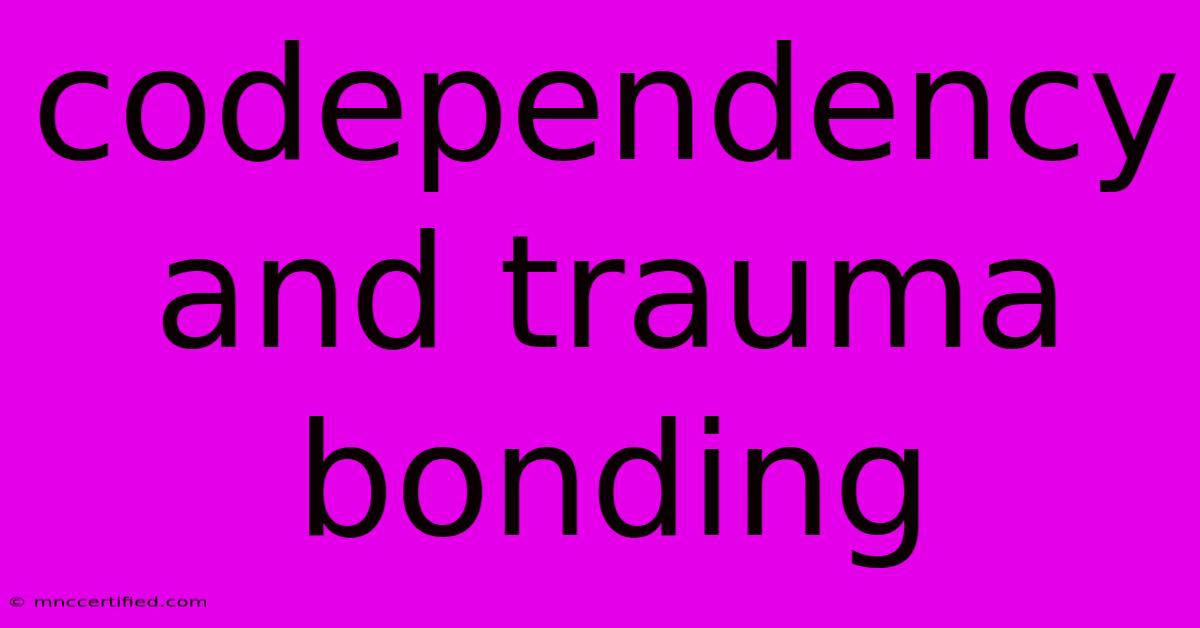Codependency And Trauma Bonding

Table of Contents
Codependency and Trauma Bonding: Understanding the Toxic Cycle
Codependency and trauma bonding are often intertwined, creating a complex and damaging relationship dynamic. While distinct, they share overlapping characteristics that can make it difficult to differentiate between them and even harder to escape their grip. Understanding the nuances of each is crucial for recognizing and breaking free from these unhealthy patterns.
What is Codependency?
Codependency is a behavioral condition where an individual's sense of self-worth is excessively dependent on the approval and validation of others. This often manifests as prioritizing the needs of others above their own, neglecting personal boundaries, and engaging in people-pleasing behaviors. Key characteristics of codependency include:
- Excessive giving: Constantly putting others' needs first, often to the detriment of one's own well-being.
- Poor boundaries: Difficulty saying "no" or asserting personal needs and preferences.
- Low self-esteem: Feeling inadequate or unworthy without the approval of others.
- Fear of abandonment: An intense fear of losing the relationship, leading to submissive behavior.
- People-pleasing: Seeking validation through constant efforts to please others.
- Caretaking: Taking on excessive responsibility for others, even if it's detrimental.
Codependency can stem from various factors, including childhood experiences, societal pressures, and learned behaviors. It's not a personality disorder, but rather a pattern of behavior that can be addressed and changed with therapy and self-reflection.
What is Trauma Bonding?
Trauma bonding, also known as Stockholm syndrome in extreme cases, describes a paradoxical attachment that develops between individuals involved in an abusive relationship. It’s a complex psychological response where the abused person develops strong emotional ties to their abuser, despite experiencing abuse and mistreatment. The key elements of trauma bonding are:
- Intermittent reinforcement: The abuser alternates between abuse and affection, creating a cycle of unpredictability that keeps the victim trapped.
- Fear and intimidation: The abuser uses fear and intimidation to control the victim, making them feel dependent on the abuser for protection.
- Emotional manipulation: The abuser uses manipulation to control the victim's emotions and perception of the situation.
- Shared trauma: Victims and abusers may bond over shared experiences of trauma, creating a sense of intimacy despite the abuse.
- False hope: The victim clings to the hope of change or reconciliation, preventing them from leaving the relationship.
- Isolation: The abuser often isolates the victim from support systems, further strengthening their dependence.
Trauma bonding is a survival mechanism. The brain seeks stability even in adverse circumstances, and forming a bond, however unhealthy, can offer a sense of predictability amidst chaos.
The Overlap Between Codependency and Trauma Bonding
The lines between codependency and trauma bonding can often blur. Individuals with codependent tendencies may be more vulnerable to trauma bonding because their need for approval and fear of abandonment make them susceptible to manipulative tactics. They may rationalize the abuse, blaming themselves or believing they deserve it. Conversely, trauma bonding can reinforce and exacerbate pre-existing codependent tendencies.
Here's how they intersect:
- Shared need for control: Both involve a struggle for control, either consciously or unconsciously. In codependency, the codependent tries to control the outcome by excessive giving, while in trauma bonding, the abuser controls the situation through fear and manipulation.
- Low self-esteem: Both conditions are often rooted in low self-esteem, making individuals more likely to tolerate unhealthy dynamics.
- Difficulty setting boundaries: Both involve a struggle to set and maintain healthy boundaries.
Breaking Free from the Cycle
Breaking free from codependency and trauma bonding requires significant effort, self-awareness, and professional help. Key strategies include:
- Therapy: Therapy, particularly trauma-informed therapy, is crucial for addressing underlying issues and developing healthy coping mechanisms.
- Setting boundaries: Learning to set and maintain healthy boundaries is essential for both conditions.
- Self-care: Prioritizing self-care activities that promote physical and emotional well-being.
- Building support systems: Developing strong and healthy support networks.
- Understanding your role: Acknowledging your part in the dynamic without blaming yourself.
Recognizing the signs of codependency and trauma bonding is the first step towards recovery. By understanding these intricate dynamics, you can begin the process of healing and building healthier relationships. Remember, seeking professional help is a sign of strength, not weakness. You deserve to live a life free from these harmful patterns.

Thank you for visiting our website wich cover about Codependency And Trauma Bonding. We hope the information provided has been useful to you. Feel free to contact us if you have any questions or need further assistance. See you next time and dont miss to bookmark.
Featured Posts
-
Cleveland State Hosts Ohio Dominican Womens Bb
Nov 23, 2024
-
Robbery Targets Pregnant Charlotte Crosby
Nov 23, 2024
-
Argyles World Cup Stadium Plans Unveiled
Nov 23, 2024
-
Uncovered Jfk Assassination Details
Nov 23, 2024
-
Infinity Bond Mp75 Pur Adhesive
Nov 23, 2024